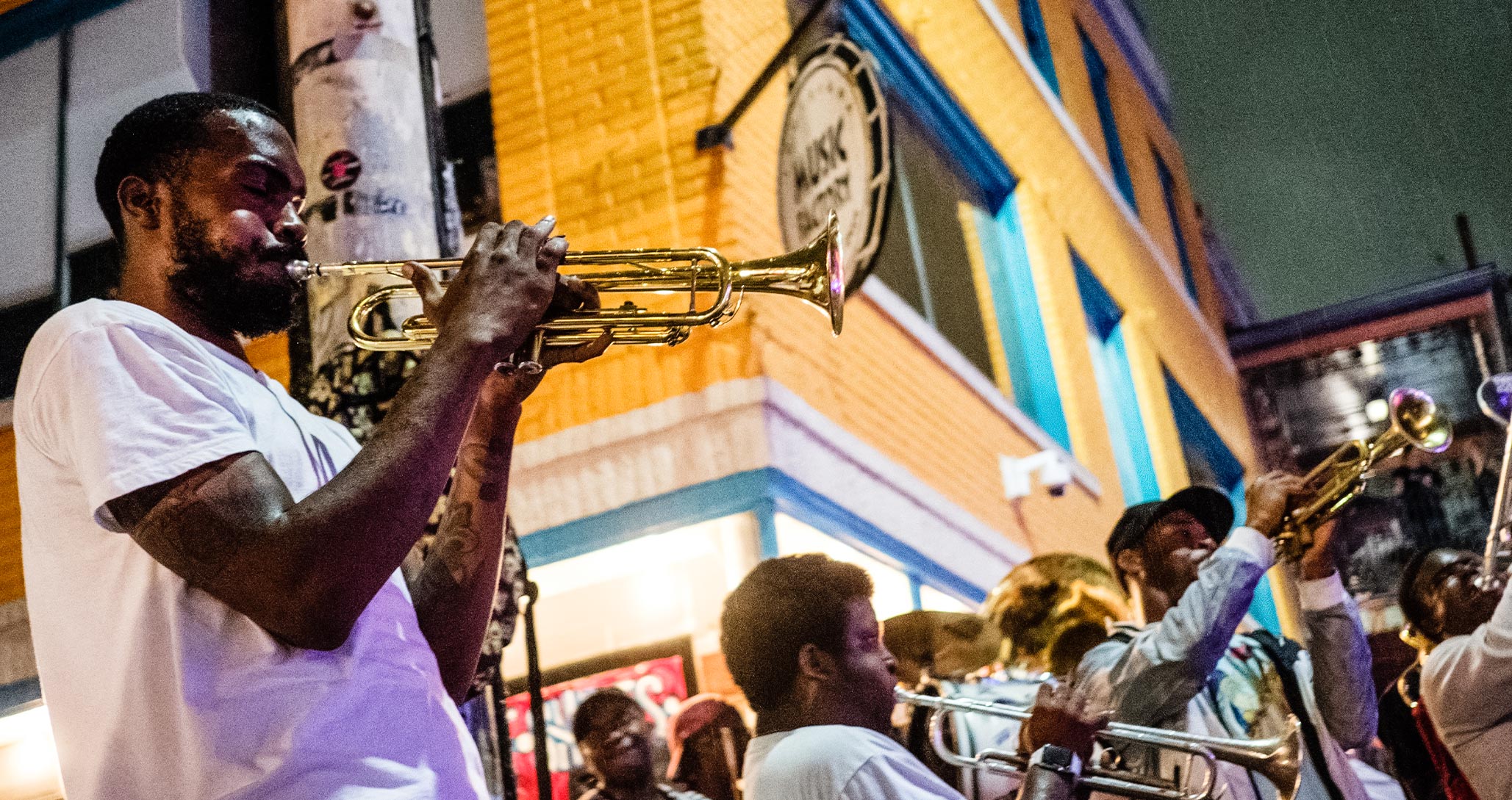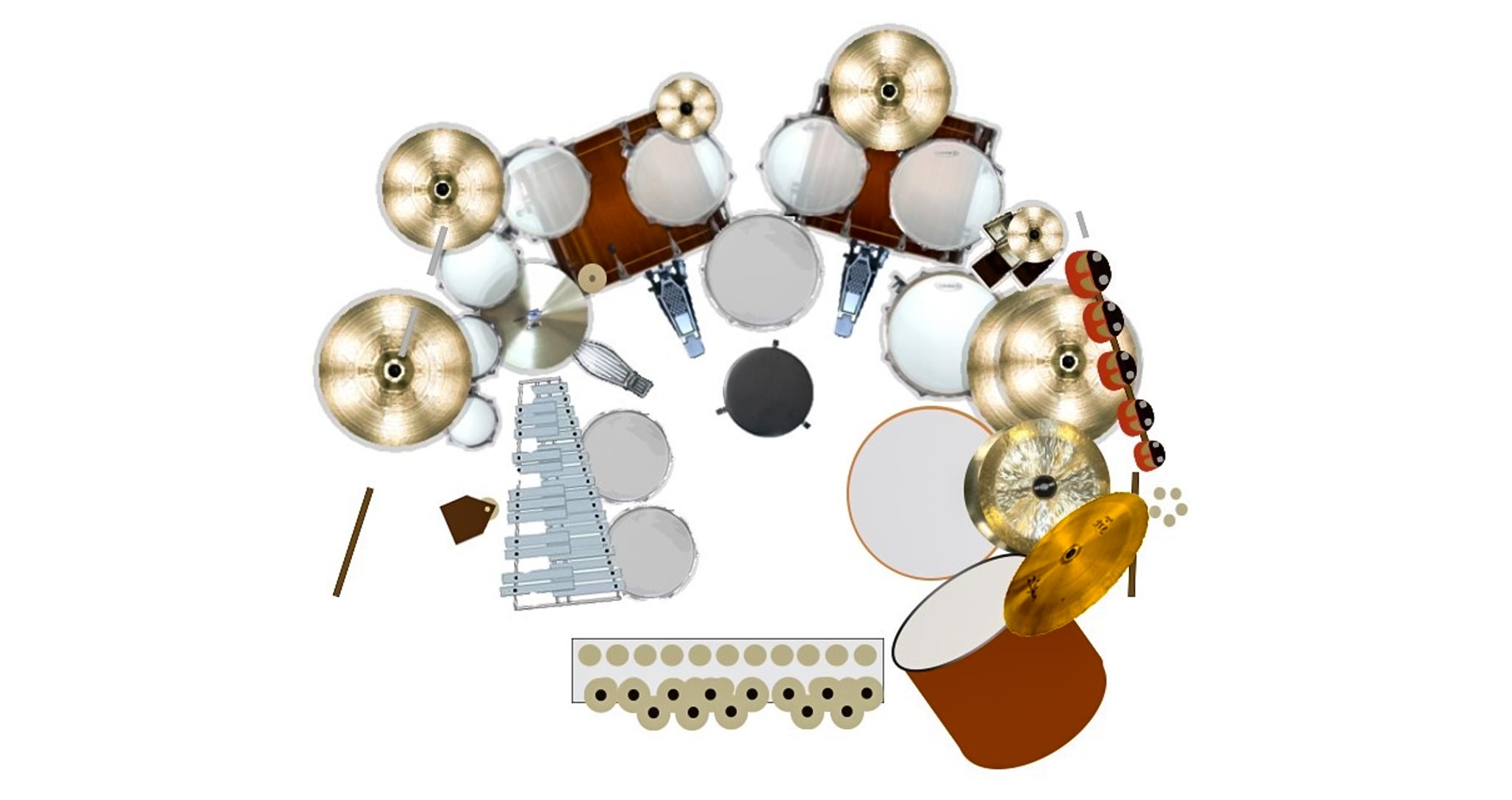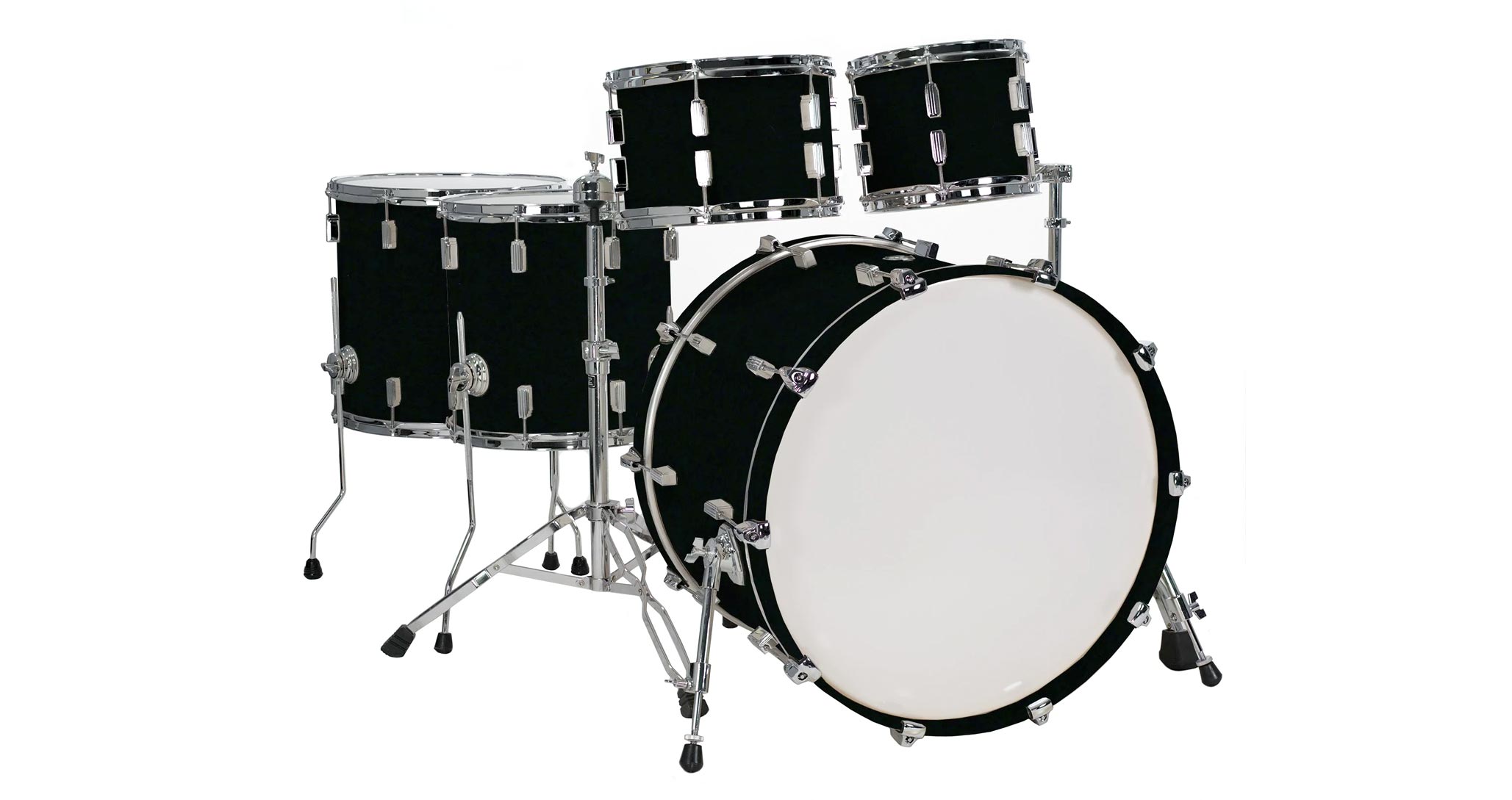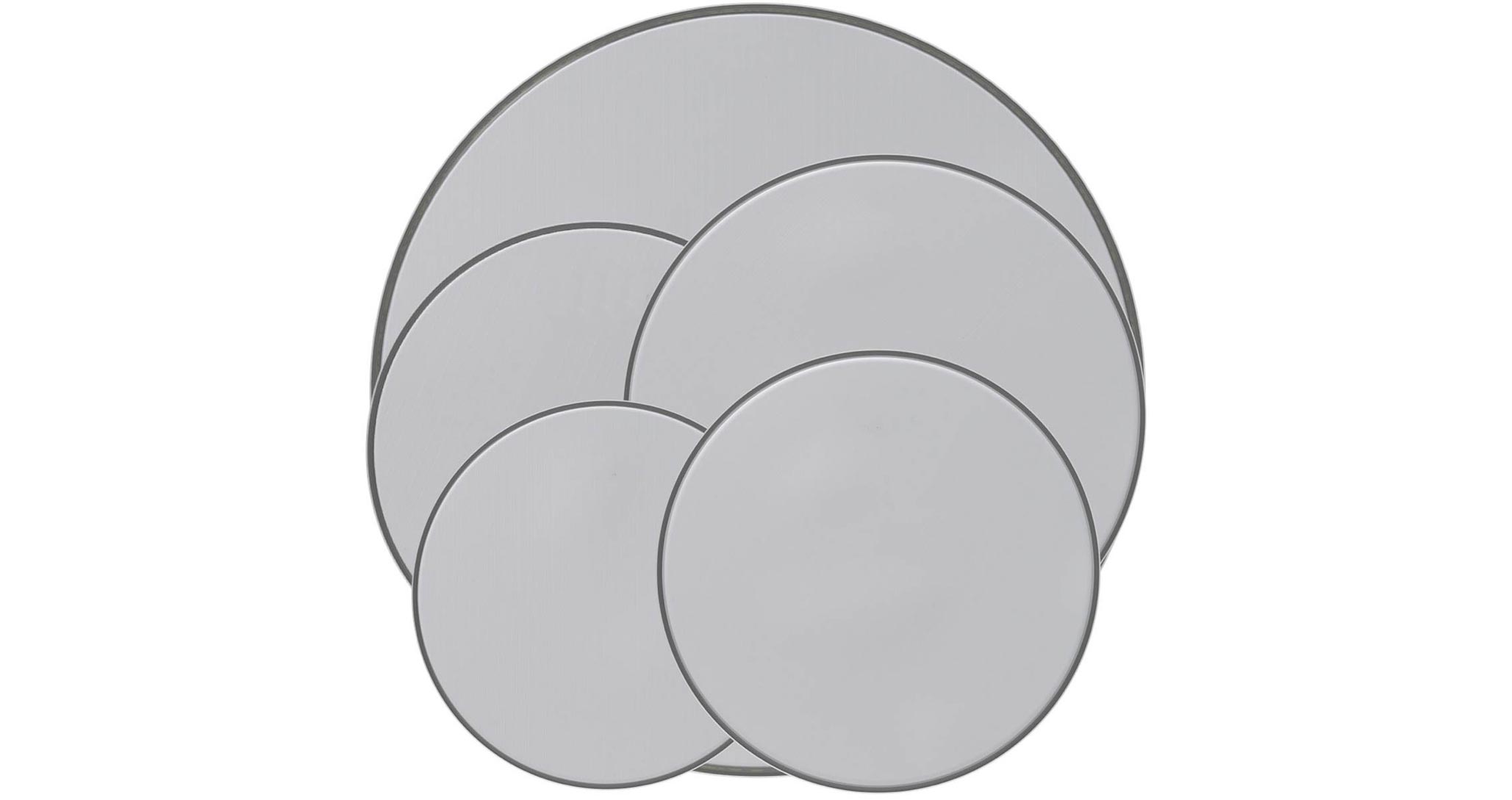A creation of musical trends and invention, Rock and Roll drums have a certain sound. The world of drums is vast! With so many styles of drumming and options for drums, what gives Rock and Roll drums their sound and how did that happen?
HOW DID THE MODERN DRUM SET EVOLVE?
Although multiple percussionists played toms, snare drums, bass drums, cymbals, and other percussion instruments in music prior to the 1900s, it was the special situation in New Orleans in the Vaudeville Era (~1880-1930) that led to a single percussionist playing a modern drum set in the way we do today.

World cultures and artists melted together in the busy American port city of New Orleans, which developed its own style of vaudeville from France. Musical variety acts were extremely popular and percussionists needed to move to various venues frequently and be able to satisfy a variety of roles in limited space. Economics also pushed for fewer percussionists, narrowing it down to a one-person job. These constraints ultimately led to innovations that enabled one person to craft the entire rhythmic feel with their own personality on a “drum set.”
Marches, driven by the snare and steady bass drum, were giving way to a new style of syncopated snare and bass drum punches known as ragtime, and a New Orleans version of this style was popularized by the Original Dixieland JASS Band who made a recording called Livery Stable Blues in 1917. This style, later called “Jazz,” became a key driver towards the modern drum set as waves of musicians imitated and developed the popular sound.

To achieve more percussion with one person, percussionists started using an ineffective spring-loaded overhanging beater on their bass drum, connected with a rope to one’s foot directly or to a board used as a pedal. This helped bring an end to “double drumming” where you had to use your hands for both bass and other drums, but this system had limitations. New Orleans drummer DeeDee Chandler created a makeshift foot pedal in 1896 that worked like a modern pedal with more control. The Ludwig Company patented a functional commercial product in 1909 that bears the modern bass pedal spring-driven design. Foot pedals for the bass drum freed up the hands to do more complex snare work or other percussion.
Early single-percussionist experimentation included a cymbal mounted to the bass drum which was struck in conjunction when using the bass drum pedal with a connected cymbal striker. It gave an additional dimension but was limited and somewhat monotonous, however, innovations allowed one to engage it when wanted. A more functional and popular invention was the low-hat pedal, which let the left foot clap together a pair of cymbals at ground level, expanding what one person could do, since all four limbs could now be involved. In another crucial step, New Orleans drummer Baby Dobbs worked with Ludwig around 1926 to raise the low-hat cymbal clappers to create the “hi-hat,” allowing it to be played with both hands and feet, as well as the addition of the side-mounted cymbal to the bass drum, leading to the prominence of the “ride cymbal” and the way it is played with sticks in modern music. Later jazz drummers evolved some of the expression of ragtime’s press rolls on the snare drum into ride cymbal work and 2 & 4 stepped hi-hat that typically characterizes jazz drumming.
The Ludwig Company also created hardware to mount “contraptions” on the kick drum along with their package of the snare, hi-hat, and bass drum with pedal, leading to the term “trap kit.” These contraptions included various percussion items such as popular non-tunable calfskin Chinese tom-toms, woodblocks, hanging cymbals, and cowbells.

Gene Krupa is credited with refining the set into the modern version. The Zildjian Cymbal Foundry created in 1623 in Turkey had relocated to the United States as the modern Avedis Zildjian Company in 1929. Avedis III sought out Gene Krupa to understand the needs of the modern drummer. Krupa and Zildjian worked together to standardize the cymbal types such as ride, crash, splash, china, and hi-hat. Krupa also worked with Slingerland to create tunable tom-toms and positioning with one mounted on the bass drum and one on the floor with legs, and including a bass drum-mounted ride cymbal. Krupa’s great charisma and skill helped bring it all together as a desirable commercial product called the “Stripped Down Kit” in 1935, and many were compelled to imitate and purchase his setup, which is what we recognize today as the modern 4-piece drum set with the hi-hat, ride cymbal, and two crash cymbals. He even pioneered the stylistic badge on the bass drum head.
Louis Belson is credited with making an early double bass design and then pioneering double bass playing by winning the Slingerland National Gene Krupa contest in 1941.
Remo Belli is credited with replacing animal skins with synthetic skins in 1950 and producing the first commercial mylar skin on an aluminum hoop in 1957, known as the Remo Weather King. It was endorsed by Gene Krupa and Buddy Rich and allowed for the louder volumes needed for Rock and Roll, evolving from Jazz.
The modern drum set was essentially a 20th Century American invention evolving from the contributions of the culture, technology, and popular artists of that time, particularly from New Orleans.

HOW TO SET UP THE DRUMS - (right-handed)
The purpose of a “set” of drums is to make the entire set easily playable while in a sitting position. The drummer sits on the drum throne with the snare drum on a stand between their knees. The left foot rests on the hi-hat stand’s pedal and the right foot rests on the bass drum pedal. The bass drum is attached to the pedal in front of it. One or two drums called toms are typically mounted over the bass drum with hardware. A tom with legs sits to the right of the right leg on the ground, called a floor tom. The toms are arranged so that they are smaller to the left and bigger to the right. Cymbals are mounted above the toms on stands. The hi-hat cymbals will sit on the hi-hat stand just to the left of the snare.
How Much Do Drums COST?
The price of drums can widely vary. Although whole sets are sold for beginners, these are usually not professional quality or possibly even toy quality. Usually, drumming gear is bought in these categories: drum shells, cymbals, hardware, and drum heads. Professionals buy all separately according to their tastes. Including all the essential pieces, Beginner sets run about $350-$700, Intermediate: $800-$1,500, and Professional: $2,000+.
DRUM SETS OF FAMOUS ROCK DRUMMERS
John Bonham - The “Green Sparkle” kit: Maple Ludwigs: 14x10 mounted tom, 16x16 floor tom, 18x16 floor tom, 26x14 bass drum. Ludwig Supra-phonic 402 14x6.5 snare. Paiste Giant Beats & 2002 series cymbals.
Jeff Porcaro - Toto Tour 1982: Maple Pearl Custom 22x18 bass drum, 10x8 tom, 12x10 tom, 13x11tom, 16x16 floor tom, 14x6.6 Slingerland Radio King snare. Paiste 2002 series cymbals.
Keith Moon - The “Pictures of Lily Kit”: Birch Premier Custom: Two 22x14 bass drums, Two 16x18 toms, 16x16 tom, Three 14x8 mounted toms, 14x5.5 snare drum. Various cymbal manufacturers.
Neil Peart - “Moving Pictures” Kit: Rosewood Tama Custom with “Vibra-Fibing”: 5.5x6 concert tom, 5.5x8 concert tom, 5.5x10 concert tom, 8x12 concert tom, 8x12 tom, 9x13 tom, 12x15 tom, 16x18 tom. Wood-shelled (Maple/Poplar/Mahogany) Slingerland Artist model 5.5x14 snare. Avedis Zildjian cymbals, and a genuine Chinese China-type cymbal. Also numerous other percussion items such as chimes, bells, gongs, temple blocks, gong bass drums, and timbales.

Dave Grohl - Nirvana “Nevermind” kit: Birch Tama Granstar: 14x15 mounted tom, 16x18 floor tom, 16x24 bass drum, 8x14 snare. Zildjian A Series Medium cymbals.
Travis Barker - Blink-182 circa 2000: Maple Orange County Drum and Percussion: 22x18 bass drum, 14x6 20-ply vented snare, 12x10 mounted tom, 16x14 floor tom. Zildjian A and Z series cymbals.
ABOUT THE DRUMS and CONFIGURATIONS
While a drum set could consist of differently constructed drums, typically the drums of a set are made with the same materials so that they have a similar overall sound, and are sold together. Therefore manufacturers offer “shell packs” consisting of the bass drum, the toms, and sometimes the snare drum. The choice of snare is often left to the consumer as a separate preference. In rock music, the snare drum is a principle component along with the bass drum, while the toms are somewhat secondary. Often the snare drum is made of metal, while the toms and bass drum are made of wood.

The wood construction of a shell pack defines a drum’s tone and timbre. Some drums are solid wood, some will have a number of layers of wood that might be of different types. The most common woods used are maple, birch, and mahogany, but there are others that are used, too. Maple is known for being fairly even in frequency distribution, birch is known for its boosted highs and lows and reduced midrange. Mahogany is known for its warm resonant sound with reduced highs.
The snare drum can be wood or metal. Snare drums can have the same wood options as toms, but are often made of metal such as aluminum, brass, copper, brass, titanium, and steel. Recent trends have metal snares in the lead for rock, with brass being a top choice along with aluminum and titanium, all known for their clarity and high end needed for rock. The aluminum Supra-phonic 400 series snare by Ludwig is considered one of the most recorded snare drums in history.
Rock drum sets can be as little as just a bass drum and snare, but typically will include a number of toms, with the most common number being three toms. If two toms are mounted and one is on the floor, then it is referred to as “2 up and 1 down.” This is the most common configuration. Another common configuration is “1 up, 2 down,” like John Bonham used, with one mounted tom and two floor toms. Other minimalist configurations are the “1 up, 1 down” used by both Dave Grohl and Travis Barker—a mounted tom and a floor tom, or just “1 down,” which just has a floor tom. How many toms you use depends on what is called for in the music. Three toms are plenty to create most textures, and you can always leave some out if not needed. Rock drummers tend to use larger drums. The most common sizes of bass drums are 22, 24, or 26 inches. Snare drums are typically 14 inches and at least 5 inches deep. Mounted toms are commonly 10, 12, or 14 inches, and floor toms are commonly 16 or 18 inches.

ABOUT DRUMHEADS
Drum sets, shell packs, and snare drums will usually come with “stock” drumheads to complete the product, but these drumheads use typically the thinnest sheets of single-ply mylar. These may not and probably will not be what you want to continue with, but will get you started. Drumheads vary by thickness (mil), by layers (single-ply, dual-ply), and by whether they are coated or not. The drumheads for the side you strike (batter heads) are different than the side you do not strike (resonant heads). The resonant heads are thinner and single-ply so that they resonate well. The batter heads are thicker, may be dual-ply, and have dampening rings, coatings, dots, or other features that relate to the effects of the side you strike. Rock drums tend to use thicker or dual-ply batter heads with the control ring to focus the sound and eliminate overtones. Clear heads are brighter, and coated heads make a warmer thick sound, dots add focus and punch. The options have become numerous for drum heads, so have fun experimenting, or see what your favorite drummer uses, but make sure you have resonant heads on the resonant side and batter heads on the batter side!

ABOUT CYMBALS and CONFIGURATIONS
When picking cymbals you will be confronted with a staggering array of options. Ultimately it is best to pick something you like the sound of, which means playing it in person, and something you can afford. A set of rock cymbals can be anywhere from $200 to $1,500 or more. Some cheap cymbals can sound reasonable in a rock setting, by using a standard manufacturing process that produces a reliable result. The best cymbals are usually hand hammered by an expert. Manufacturers have cymbal packs that make the purchasing process easier, but you will not have as much control over what you get or the sound you are going for. Zildjian, Sabian, Paiste, and Meinl are all current manufacturers of cymbals of varying quality and tone. Each manufacturer will have different series that represent levels of quality or sonic texture. Some drummers might use all the same series, but others pick certain types for each job. The typical rock cymbal configuration will be a hi-hat pair, a large “ride” cymbal, and two smaller “crash” cymbals of different sizes. Rock drummers tend to use thicker cymbals that will hold up to the power of rock and roll. The cymbals mainly need to cut through the amplified band, so crisp hi-hats, punchy crashes, and a tight ride sound are common characteristics of rock cymbals. Keep in mind that cymbals do not really devalue with use unless they become cracked, chipped, or keyholed from the stand, so buying used undamaged cymbals that you like and are affordable is not a problem and you might find better value.
POPULAR ROCK SONGS FEATURING DRUMS
To hear those famous rock drummers on their drum sets, check out these great performances, which are all available in the School of Rock App!
- John Bonham on “Good Times Bad Times” by Led Zeppelin
- Jeff Porcaro on “Rosanna” by Toto
- Travis Barker on “All The Small Things” by Blink 182
- Neil Peart on “Tom Sawyer” by Rush
- Keith Moon on “The Real Me” by The Who
- Dave Grohl on “Lithium” by Nirvana
About the Author
Grady Humble is a drum teacher, guitar teacher, and bass guitar teacher at School of Rock SW Austin.






